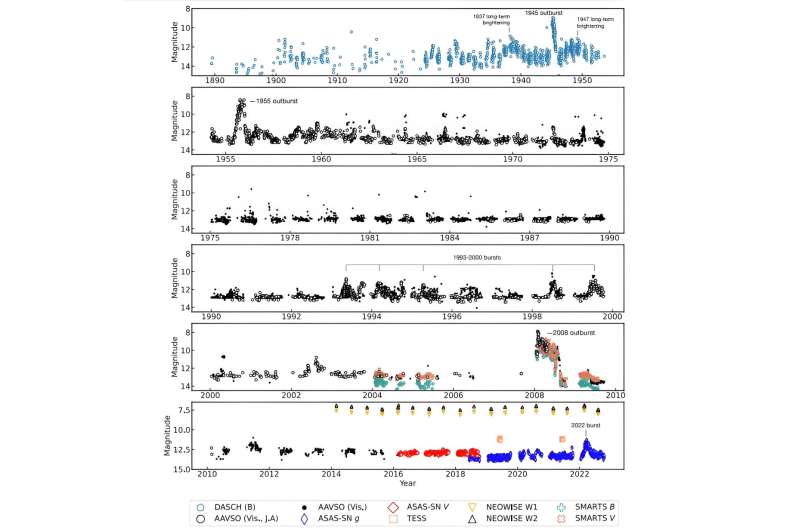August 31, 2023 report
This article has been reviewed according to Science X's editorial process and policies. Editors have highlighted the following attributes while ensuring the content's credibility:
fact-checked
preprint
trusted source
proofread
Research sheds more light on the accretion history of EX Lupi

An international team of astronomers has investigated EX Lupi—a young T-Tauri star in the constellation of Lupus and an archetype of EXor stars. The study, presented in a paper published August 23 on the pre-print server arXiv, provided important insights into the accretion history of this star.
Located some 514 light years away, EX Lupi is a variable star with a mass of about 0.6 solar masses and a radius of 1.6 solar radii. It represents the prototype of young eruptive stars known as EXors—low-mass pre-main sequence (PMS) stars whose episodic eruptions are due to temporarily increased accretion.
EX Lupi has been monitored since 1893, what revealed several large outbursts: in 1945, 1955, and 2008. However, although the star has been extensively observed for over 100 years, its accretion history is still not fully understood.
That is why a group of astronomers led by Mu-Tian Wang of the Nanjing University in China decided to re-analyze the available observational data regarding EX Lupi. They assembled the light curve of EX Lupi from 1895 to 2023 to assess the role of accretion bursts and outbursts in this star.
"With the improved knowledge about the variability link between mass accretion rate and photometry, we return to the century-long photometry data of EX Lupi to measure the mass accreted in bursts and compare that to the mass accreted during quiescence," the researchers explained.
The study found that the brightness increases observed in EX Lupi over the past 128 years can be divided into major outbursts and characteristic bursts. Three major outbursts were identified (in 1945, 1955 and 2008), while 14 characteristic bursts were detected in the past 70 years and the last one occurred in 2022.
In general, the major outbursts turned out to be relatively rare. They showcase a brightness increase of about 5.0 mag, have year-long durations, reach accretion rates of about 0.033 Earth masses per year at peak, and have a total accreted mass of around 0.1 Earth masses.
When it comes to characteristic bursts (with brightness increase of about 2.0 mag), they are more common and last shorter than major outbursts—about 2–3 months. They reach accretion rates of 0.0033 Earth masses and total accreted mass at a level of approximately 0.001 Earth masses.
Furthermore, the astronomers found that roughly half of the mass of EX Lupi accretes during major accretion bursts and half accretes during characteristic bursts and quiescence. The results also suggest different driving mechanisms behind the major outburst and characteristic bursts.
Summing up the study, the researchers noted that they predict several more characteristic bursts in EX Lupi in the next decade. They propose additional spectroscopic observations to follow the accretion and ejection processes during the next burst.
More information: Mu-Tian Wang et al, The Accretion History of EX Lup: A Century of Bursts, Outbursts, and Quiescence, arXiv (2023). DOI: 10.48550/arxiv.2308.11895
Journal information: arXiv
© 2023 Science X Network





















